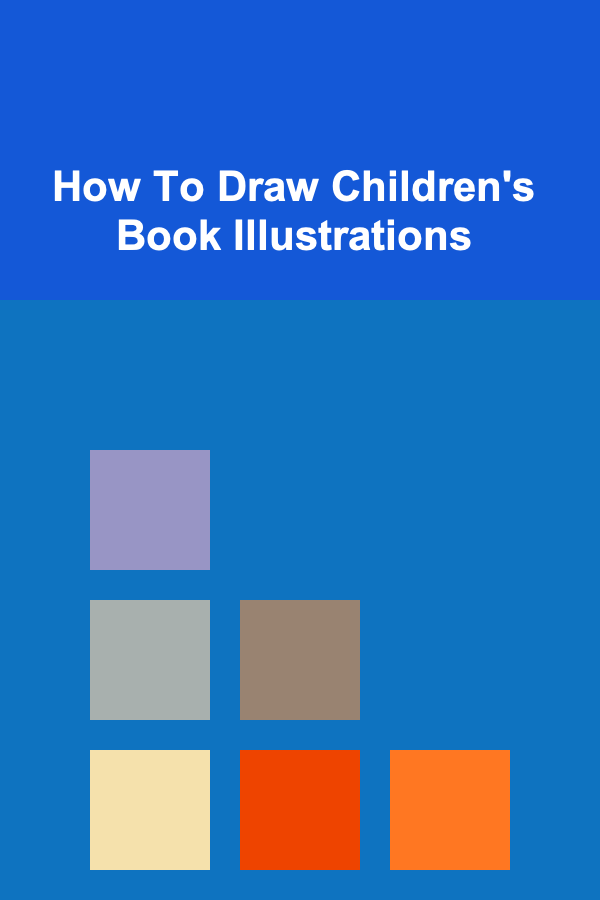
How To Draw Children's Book Illustrations
ebook include PDF & Audio bundle (Micro Guide)
$12.99$11.99
Limited Time Offer! Order within the next:

Creating illustrations for children's books is an art form that combines storytelling with visual creativity. The illustrations serve as a bridge between the written word and the imagination of young readers, making it essential for illustrators to not only be skilled artists but also empathetic creators who understand the emotional and cognitive stages of a child's development. Whether you're an experienced illustrator or just starting out, this guide will take you through the key principles, techniques, and considerations for drawing children's book illustrations.
Understanding the Role of Illustrations in Children's Books
Before diving into the technicalities of drawing, it's important to understand the significance of illustrations in children's books. They aren't just decorative; they play a fundamental role in storytelling. For young readers, illustrations are often their first introduction to storytelling. They help to:
- Enhance the Narrative: Pictures allow children to understand the story better by visually reinforcing the text. Complex concepts, settings, and characters can be made accessible through images.
- Spark Imagination: Illustrations stimulate a child's imagination, helping them visualize the world in new and exciting ways.
- Develop Emotional Connection: Children often connect emotionally with the characters and situations presented in illustrations, which can enhance their learning experience.
- Encourage Reading: A well-illustrated book grabs a child's attention and motivates them to read, especially for early readers who might struggle with just text.
In summary, illustrations are an essential storytelling tool, guiding young readers through the plot, fostering emotional engagement, and building a bridge between words and the world around them.
Steps to Drawing Children's Book Illustrations
Step 1: Understand Your Audience
One of the first steps in creating effective children's book illustrations is understanding the age group of your audience. Different age groups have different needs and preferences:
- Infants (0-2 years): Illustrations for this age group should be bold, simple, and highly visual. High-contrast images, with primary colors, are ideal as infants' visual systems are still developing.
- Toddlers (2-4 years): At this stage, children are starting to understand simple narratives and can process more detailed images. Illustrations should feature larger characters and simple scenes that depict emotions and activities they can relate to.
- Early Elementary (4-7 years): Children in this age group are beginning to read independently, and illustrations should work as companions to the text. These images should be colorful, dynamic, and detailed, showing action and character expression to hold the child's attention.
- Older Children (7-12 years): For this age group, illustrations can be more sophisticated, and the characters and settings can be more complex. They may complement the plot with additional details, supporting the deeper themes of the story.
Knowing the specific developmental and cognitive needs of your target age group will help you create illustrations that speak directly to them.
Step 2: Plan Your Illustrations
Planning is crucial in the illustration process. The key elements to consider when planning include:
- Storyboards: A storyboard is a series of sketches that outline the basic scenes of the story. This is the first visual step in translating the story from text to imagery. Storyboards allow you to plan the pacing of the book, showing where the illustrations will appear and how they will flow from one scene to the next.
- Character Design: Spend time developing your characters before drawing them in the book. What makes them unique? What are their emotional states and personalities? Ensure that each character's design is simple enough for children to understand, yet distinct enough to be memorable.
- Setting and Environment: The setting can be just as important as the characters. If your story takes place in a magical forest, for instance, your illustrations should evoke a sense of wonder and adventure. Be mindful of the mood you want to convey with the background scenes.
- Page Layout: Children's books often have a set number of pages for each illustration. Think about how much of each page will be filled with the image and how it will relate to the text. The layout should support the story's rhythm, providing moments of calm or action as needed.
Step 3: Start Drawing
Once you've planned the overall design and layout of your book, it's time to start drawing. Here are some key techniques to keep in mind:
- Keep It Simple and Clear: Children's illustrations need to be visually simple. Avoid overwhelming the viewer with too much detail. Instead, focus on bold, clear shapes and a limited color palette. This helps young readers focus on the main characters and key elements of the story.
- Emphasize Expression: Children connect deeply with characters' emotions. Ensure that your characters' facial expressions and body language are easy to read and convey the right emotions. For instance, if a character is sad, their face should be drawn in a way that clearly shows it, with slumped posture or downturned eyes.
- Use Color Effectively: Colors are a powerful storytelling tool in children's book illustrations. Bright, cheerful colors can convey happiness and excitement, while muted tones can evoke sadness or mystery. The color choices should match the tone of the story and enhance the emotional impact.
- Play with Perspective: Using perspective can add depth and interest to your illustrations. Children often respond to illustrations that show dynamic perspectives, such as an aerial view of a character or a close-up of an object. This makes the story feel more engaging and helps the child become immersed in the world of the book.
- Consider Texture and Pattern: Adding textures, such as soft backgrounds or patterns on clothing, can make your illustrations more visually stimulating and provide a tactile experience for young readers.
Step 4: Incorporating Text and Illustrations
In children's books, text and images work together. The placement of the text on the page is critical because it needs to complement the illustration without overwhelming it. Consider the following when integrating text with illustrations:
- Text Placement: Avoid placing text over important parts of the illustration. The text should be legible and not distract from the visual story. Often, text is placed in the margins or in clear spaces within the illustration to ensure readability.
- Text Size and Font: Use a font that is easy to read and fits the tone of the story. For younger children, a large, simple font is best. As the child's reading abilities grow, you can opt for more complex fonts, but readability should always come first.
- Illustration-Text Balance: Aim for a balance between images and text. Early readers may rely more heavily on the illustrations to understand the story, so you want to make sure the illustrations adequately support the text. For more complex stories, text may dominate, but illustrations still play an essential role in supporting the narrative.
Step 5: Refining and Finalizing the Illustrations
After sketching and working through your rough drafts, the next step is refining your illustrations. This is when you add fine details, correct proportions, and ensure consistency across all the illustrations.
- Consistency is Key: Ensure that characters, colors, and overall style remain consistent throughout the book. If you draw a character a certain way on one page, they should appear the same way on all pages. This helps create a cohesive visual narrative that children can follow.
- Feedback and Revisions: Once you have a set of finished illustrations, it's helpful to get feedback from others, whether it's from editors, writers, or even children themselves. Feedback can help you understand if your illustrations are achieving the desired effect and whether they connect with the target age group.
- Final Touches: Once revisions are made, finalize the illustrations. This may involve digitizing hand-drawn illustrations, refining line work, adding texture, or adjusting color schemes.
Step 6: Publishing and Presentation
When your illustrations are completed, it's time to prepare them for publishing. Whether you're submitting your illustrations to a publisher or self-publishing, ensure that they are formatted correctly for print. This includes ensuring that the resolution is high enough for printing and that each illustration fits the page layout.
Conclusion
Drawing children's book illustrations is an exciting and rewarding endeavor. By understanding the developmental stages of your audience, planning your work carefully, and focusing on clarity, emotion, and story enhancement, you can create illustrations that resonate with young readers. Whether you're illustrating a picture book for toddlers or an illustrated chapter book for older children, your art will play a key role in shaping the reader's experience and sparking their imagination.
The world of children's book illustrations is rich with opportunity. By honing your skills and embracing the joy of creative storytelling, you can make a lasting impact on young readers around the world. Happy illustrating!

How to Label Storage Boxes for Seasonal Clothing
Read More
How to Set Up Automated Follow-ups After Dropshipping Webinars for Better Conversion
Read More
How to Use Recessed Lighting to Create a Sleek Look
Read More
How to Use VR for Architectural Visualization
Read More
How To Say "No" Politely in Different Cultures
Read More
Finding Challenging Hiking Trails: A Comprehensive Guide
Read MoreOther Products

How to Label Storage Boxes for Seasonal Clothing
Read More
How to Set Up Automated Follow-ups After Dropshipping Webinars for Better Conversion
Read More
How to Use Recessed Lighting to Create a Sleek Look
Read More
How to Use VR for Architectural Visualization
Read More
How To Say "No" Politely in Different Cultures
Read More